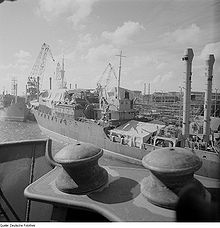Tropics
| Tropik series | |
|---|---|

|
|
| Technical data (overview) | |
| Ship type: | Catch and freeze ship stern trawler |
| Shipyard: | Volkswerft Stralsund |
| Measurement: | 2435 BRT / 1070 NRT |
| Length over all: | 79.8 m |
| Length betw. D. Soldering: | 71.0 m |
| Width on frames: | 13.2 m |
| Side height: | 7.0 m |
| Draft: | 4.9 m |
| Speed: | 11.7 kn |
| Displacement: | 3050 t (3305 t) |
| Load capacity: | 862 t (909 t) |
| Drive: | 2 diesel engines type 8 NVD 48 |
| Total output: | 985 kW (with additional electric motor 1220 kW) |
| Crew: | 76 men |
The large series Tropik was a series of catching and freezing ships that were produced between 1962 and 1966 at the Volkswerft Stralsund . A total of 88 units of the rear trawler designed for tropical waters were manufactured. Two of them, the Stubnitz and the Granitz , were modified versions that were used as refrigeration and transport ships for catching herring .
technology
Two four-stroke diesel engines, each with an output of 493 kilowatts, drove a variable-pitch propeller via induction clutches and a shared gearbox . An electric motor was coupled to the shaft, which could be used as an additional drive or generator. There were four diesel generators with 270 kW and two with 100 kW power on board for the electrical energy supply. The service speed was 11.7 knots. An active rudder enabled particularly good maneuverability.
The ships were equipped in many ways for fishing. Basic and trawl gear were used to catch herring-like fish, sardines and round fish. Using a multi-drum winch, the catch was pulled over the 4 meter wide rear slip system onto the 18 meter long catch deck. Light fishing equipment with a fish pump was available for sardine fishing. One or two Doriboats and a workboat were used to catch tuna with longline fishing and purse seine . 935 cubic meters of fish space were available for catches that were caught either by their own or from feeder trawlers, as whole fish or split up for large fish. The possible catch capacity was 60 tons per day. The fish was frozen in a stream of cooling air and stored in the 470 ton deep freezer. 30 tons could be frozen in 22 hours at −25 ° C.
literature
- Alfred Dudszus, Alfred Köpcke: The big book of ship types. Steam ships, motor ships, marine technology from the beginnings of machine-driven ships to the present day. transpress Pietsch, Berlin Stuttgart 1990, ISBN 3-344-00374-7 , p. 279.
Web links
- Main features of the Tropik series fishing and freezing vessels. Retrieved September 12, 2009 .
